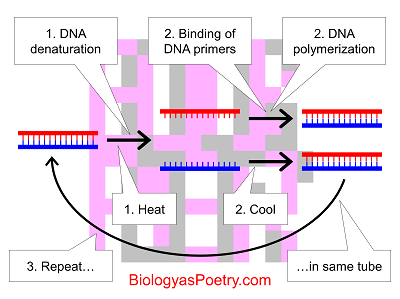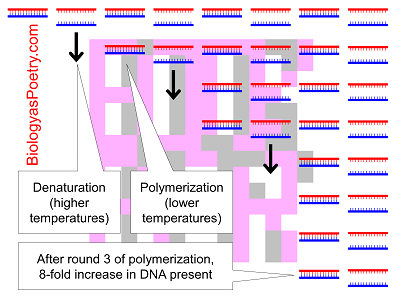∞ generated and posted on 2016.03.18 ∞
In vitro means of substantially amplifying copies of specific DNA segments, ones up to a few kilobases in length.
The basic premise behind polymerase chain reaction is the repeated replication of DNA under circumstances that are both relatively simple in terms of what enzymes need to be present and relatively simple in terms of effort on the part of the individual performing the procedure. This utility is achieved through the use of heat to present single-strands of DNA to DNA polymerase, rather than double helix, and is done in combination with the use of a heat-tolerant DNA polymerase such that the heat required to effect DNA denaturation does not also result in DNA polymerase denaturation.

Figure legend: Polymerase chain reaction basics: Heat → denature DNA → cool → prime → polymerize → repeat.

Figure legend: Polymerase chain reaction such as occurring in a thermocycler. Higher temperatures denature the DNA (as indicated by the arrows) while lower temperatures allow polymerization. Moving from left to right, the result is literally an exponential increase in the amount of DNA present, though at the expense of one primer along with countless dNTPs per round polymerization. Thus, there are limits to how much DNA can be produced in a single batch within a single tube (and tubes tend to be small since it is easier to heat and cool small volumes versus larger ones). Note that as shown this is not a representation of a gel. Instead, time is flowing from left to right while DNA is accumulating from top to bottom.
Polymerase chain reaction can be viewed as an alternative to gene cloning as a means of DNA amplification, as a means of increasing the amounts of otherwise very rare DNA (such as may be found at a crime scene or in ancient bones), or as a means of generating relatively large amounts of DNA as a precursor to gene cloning.